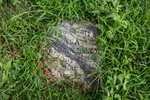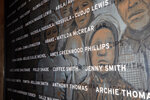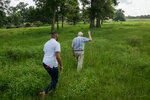The stone on Amey Greenwood Phillips grave is gone, plowed over by progress when businesses cemented the tiny plot on Highway 98 in Daphne. The plantation where she lived and worked as a slave in Loxley is gone, too. Relatives don't even know the name she was given by her parents in Africa before she was stolen from her home, dragged …
This item is available in full to subscribers.
Please log in to continue |







The stone on Amey Greenwood Phillips grave is gone, plowed over by progress when businesses cemented the tiny plot on Highway 98 in Daphne.
The plantation where she lived and worked as a slave in Loxley is gone, too.
Relatives don't even know the name she was given by her parents in Africa before she was stolen from her home, dragged across the Atlantic and made a slave.
In fact, many in her family tree never knew of her treacherous 45-day journey across the Atlantic.
They didn't know she was one of the last people to be forced into the transoceanic slave trade, which had been outlawed in the United States more than 50 years earlier.
But now, the world will know.
Earlier this month, Amey's descendants and those of 109 others aboard that last slave ship were given a place for their story to be told with the opening of Africatown Heritage House and "Clotilda: The Exhibition"
"It has been a long journey to get Amey recognized as one of the 110 Clotilda victims who were sold to Baldwin County plantations," said Marquis Watkins, her grandson, several generations removed. "Many didn't know of the Baldwin County Clotilda victims. Now we are able to say 'Amey you're not forgotten.'"
On July 8, 1860, the Clotilda arrived under cover of night in Mobile Bay. Aboard the schooner were 110 souls, several of whom died during the harrowing trip from Africa's western coast in what is present-day Benin and Nigeria.
Some were prisoners of war. Others were captured by slave traders snatched in violent attacks on villages that left many residents dead. Those who survived, men, women and children, were marched from their homes to the ship, tied together in a line. Along the walk, some were sold to other slave traders. Others were killed.
When the Clotilda's captain, William Foster, arrived, he purchased 125 people for $9,000. They were stripped naked and loaded onto the ship.
As they did, two steamer ships approached. Fearful of being arrested, Foster left 15 people on the beach as he hurried to outrun authorities.
The 110 are just a handful of millions of kidnapped African men, women and children trafficked during the Transatlantic Slave Trade between the 16th and 19th centuries.
More than 35,000 ships crossed the seas separating 13 million people from their homes and families. Only 15 ships have been located. The Clotilda is the only American slave ship to ever be recovered.
When the Clotilda arrived in Mobile, a tugboat pulled the ship up the west side of Twelve-Mile Island where it was burned in 20 feet of water. What didn't burn, sank.
Over the years, false narratives claimed the ship never existed.
Many descendants of the 110 went on to build the Africatown community in Mobile after the 13th Amendment abolished slavery in 1865.
"We knew it was here because we're here," said Altevese Rosario, whose great-great-great-grandfather, Cudjo Lewis, was aboard the ship. His oral histories, recorded decades ago, guide visitors through the exhibit.
Rosario said the community believed no one would ever look for the ship because that would be the proof it did exist.
"There were powers that didn't want that proof," she said.
Over the years, passersby could see pieces pop out of the water during low tide. That is until it was dynamited and sunk further into the murky depths.
But the ship was found thanks to tireless efforts by Baldwin County resident Ben Raines who confirmed in 2019 the ship indeed had been in plain sight all along.
Though its criminal captain tried to cover the evidence, merely sinking the ship wasn't enough. The insides of the converted hull, where the captives had just 5 feet of space per person, remained largely intact.
This cramped, dark space is where they ate, slept and went to the bathroom. Evidence of that doesn't completely disappear, not even in a muddy riverbed.
While historians believe the majority of the captives were kept in Mobile, several were sold to other landowners across Alabama, including Amey who would eventually be sold to John Greenwood in what is now Loxley. That, too, is where she was named Amey Greenwood.
Watkins is Amey's great-great-great-great-grandson. As a 2008 graduate of Fairhope High School and now a resident of Atlanta, Georgia, he says he knew little about her traumatic past because of the time span between their two generations.
A Mobile news article in the late '90s changed that.
A feature about Amey's granddaughter-in-law, Rubena Grisby Marino, who was believed to be between 103 and 106 years old, talked about Amey's connection to the Clotilda.
Diaries belonging to Watkins' great-great-uncle, Amey's grandson, retold how Amey was loaned out to another plantation, where she was beaten. When her owner learned about the abuse, he brought her back.
In an unexpected turn, Watkins even learned he worked for a law firm established by the same family responsible for bringing the Clotilda to America.
The Meaher family, who took many of the people on the ship to keep as slaves or sell, later married into the Lyons family, which owned Lyons Pipes and Cooks law firm in Mobile. Four generations later, Watkins was employed at the firm, known in modern Mobile as Phelps Dunbar.
"It's crazy that I worked for the family whose ancestors were responsible for bringing my ancestor over," he said.
Watkins' research led to more discoveries. First, he said, he doesn't think Amey was the only Clotilda survivor to land in Baldwin County.
At the church she attended, Little Bethel Baptist Church in Daphne, an historic marker on the property names another survivor, Lucy, who also attended the church. There are records of Africatown pastors coming to preach at the church as well.
As historians continue to search for the other 75 souls on Clotilda whose identities were lost on that journey, Watkins said he thinks more may have been sent to Baldwin County than previously believed.
Articles from a 1906 Baldwin Times mention previous slave ships that arrived in Mobile and had sold slaves on the Tensaw River, in Baldwin County.
He believes the risk of hiding slaves and traveling throughout the state may have been too great.
"You would try to get rid of as much cargo as you could before sending it to Selma," he says. "I believe Meaher followed the same passages as previous ships, selling the slaves in the northern part of Baldwin County where large plantation owners grew cotton, rice and indigo.
"Also, Meaher owned land in the northern part of the county, so geographically Baldwin County would have been the place to send the Africans."
Watkins also learned that Amey had two children with Benito Moreno, the son of one of Pensacola's most prominent families and friends of the Greenwoods, but the pair never married or even lived together.
Those children were toddlers when Moreno died around 1864. At the time, Amey was still a slave, and the Greenwood family gave her a photo of Moreno, a momento the family still has today.
As her children grew, they spelled the last name as Marino, a spelling that continues through the family lineage today.
As a slave, Amey was never afforded any part of the family's fortune or even a mention in present-day museums about the family, though Watkins has been in touch with members of that side of the family to swap details and stories and fill in leaves on the connecting family tree.
"Do I think we should be entitled to something? Yes," Watkins said.
Watkins regrets more that Moreno's family members found no need to mention the woman who he repeatedly returned to visit, the slave he loved and created two children with.
Moreno died at the Greenwood Plantation unmarried with no recorded children.
"Maybe we need to look at this as turning poison into medicine," Watkins said. "Maybe we all just need to join hands, no matter what color we are or what tribe or what nation. When we cut, we bleed the same blood."
The Clotilda remains buried in the mud. It can't be seen by large manufacturing ships or smaller party boats that float past.
At the opening of the Africantown Heritage House, state historians told reporters they hope to get signage over the site to guard against further damage to the wreckage.
In the exhibit, a darkened room is home to pieces of the ship. They seem to glow inside square aquariums where clear water with tiny pristine bubbles envelop the wooden parts that were plucked from the Clotilda.
Reporters asked the descendants, "Will they press for officials to raise the ship?"
Right now, they said, it's about the 110.
Each year on July 8, the Africatown community gathers and hosts a weekend-long event to commemorate the Clotilda's landing day. This year, the celebration kicked off with the opening of the Africatown Heritage House.
"It's joyous to know that people want to know about our family," Rosario said during an hours-long schedule of media interviews with national, international and local reporters descending upon the neighborhood.
She stood with other descendants in Africatown's Mobile County Training School, surrounded by walls painted Clotilda blue, a palette chosen specifically for the buildings the ship's survivors knew would be most important in strengthening their community — schools and churches.
Rosario's great-great-great-grandfather, Cudjo Lewis, was one of those founders. She grew up at the feet of her grandmother, listening to the same stories her grandmother heard at the feet of her grandfather, Lewis.
Now, Rosario is overwhelmed by the desire of the rest of the world to hear those stories, too.
"To know that other people want to know this story that I've always valued and viewed as significant," she said, "it's amazing to watch others listening to his words and reading his words and being moved by his words."